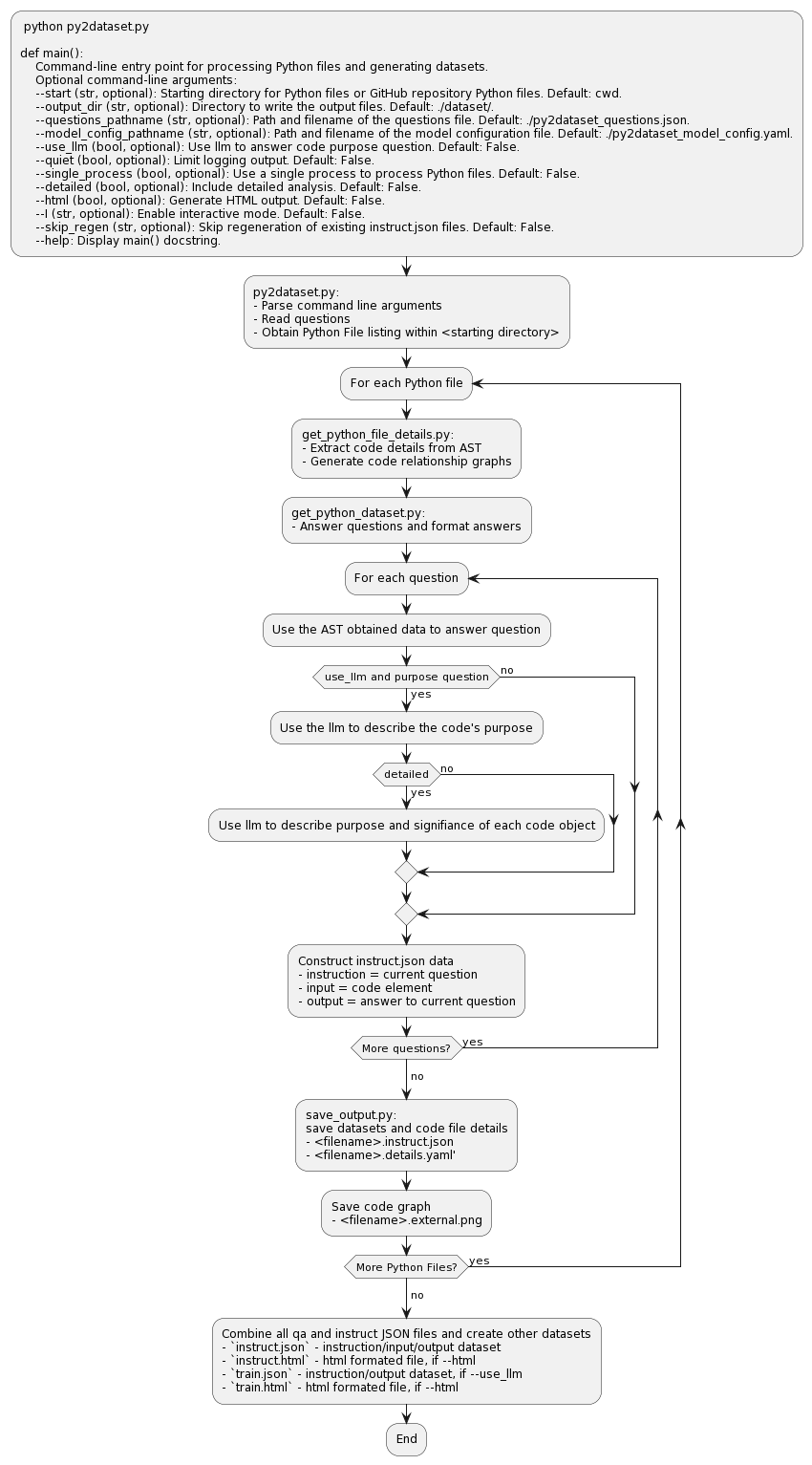py2dataset analyzes source code to generate structured datasets describing code content and behavior. It extracts information from Python files and converts it into JSON-formatted datasets. These datasets can help you understand Python software or train AI systems.
py2dataset flexibly and extensibly analyzes source code to generate descriptive datasets for understanding and learning Python code.
py2dataset performs the following functions:
- Obtain questions from the
py2dataset_questions.jsonfile or from the questions filename provided in the command line - Obtain a file listing of all of Python files at given local directory or github repository
- Parse each Python file using the Abstract Syntax Tree (AST) and visitor design pattern to build a representation of the code structure, functions, classes, methods and variables
- Generate information for the output datasets in instruction-input-output triplets using code snippets as context to answer the questions about the Python file characteristics
- (Optional) Invoke a language model to generate responses to questions about the purpose of each file, function, class, method, and variable
- Output
<filename>.instruct.jsondatasets, and a<filename>.details.yamlcontaining the AST analysis to the local./datasetdirectory or the command line specified output directory - Create image of the code call graph for the functions and classes within each python file and save in the same output directory
- Combine the datasets for all individual Python files together to produce a final
instruct.jsonin the same output directory
Clone the repository and install dependencies:
```bash
git clone https://github.com/jeffmeloy/py2dataset.git
pip install -r requirements.txt
```
Example usage:
```bash
python py2dataset.py <optional arguments>
```
Optional arguments:
--start <starting directory>: Starting directory or GitHub repository Python files. Default: current working directory.--output_dir <output directory>: Directory to write the output files. Default: ./dataset/.--questions_pathname <question file pathname>: path & filename of questions file. Default: ./py2dataset_questions.json.--model_config_pathname <model configuration file pathname>: Path and filename of the model configuration file. Default: ./py2dataset_model_config.yaml.--use_llm: Use llm for generating JSON answers. Default: False.--quiet: Limit logging output. Default: False.--single_process: Use a single process to process Python files. Default: False.--detailed: Include detailed analysis. Default: False.--html: Generate HTML output. Default: False.--I: Interactive mode. Default: False.--skip_regen: Skip regeneration of existing instruct.json files. Default: False.--help: Display main() docstring.
The following questions are answered by parsing the AST:
- Dependencies of Python file: '{filename}'?
- Call code graph of Python file: '{filename}'?
- Functions defined in Python file: '{filename}'?
- Classes defined in Python file: '{filename}'?
- Inputs to function: '{function_name}' in Python file: '{filename}'?
- Docstring of function: '{function_name}' in Python file: '{filename}'?
- Calls made in function: '{function_name}' in Python file: '{filename}'?
- Variables defined in function: '{function_name}' in Python file: '{filename}'?
- Returns from function: '{function_name}' in Python file: '{filename}'?
- Methods defined in class: '{class_name}' in Python file: '{filename}'?
- Docstring of class: '{class_name}' in Python file: '{filename}'?
- Attributes of class: '{class_name}' in Python file: '{filename}'?
- Variables defined in class: '{class_name}' in Python file: '{filename}'?
- Inheritance of class: '{class_name}' in Python file: '{filename}'?
- Inputs to method: '{method_name}' in class: '{class_name}' in Python file: '{filename}'?
- Docstring of method: '{method_name}' in class: '{class_name}' in Python file: '{filename}'?
- Calls made in method: '{method_name}' in class: '{class_name}' in Python file: '{filename}'?
- Returns from method: '{method_name}' in class: '{class_name}' in Python file: '{filename}'?
If --use_llm, the dataset includes the llm response to the file_purpose question in the --questions_pathname file
If --use_llm and --detailed, the dataset includes the purpose and signicance of each code object
py2dataset.py- Main scriptget_params.py- Validates parameter path and file name arguments, returns questions and modelget_python_file_details.py- Extracts details from Python files using ASTget_code_graph.py- Obtain call code graphget_python_datasets.py- Generates question-answer pairs and instructionssave_output.py- Save the output datasets, optional graph images and .html filespy2dataset_questions.json- Standard questions for Python files, functions, classespy2dataset_model_config.yaml- Configuration for language model
Currently configured to use ctransformers with the default configuration defined in py2dataset_model_config.yaml
```yaml
prompt_template: "Provide complete structured response for a formal software audit. Given this Context:\n'{context}'\n\nPlease provide a very detailed, accurate, and insightful Response to this Instruction and include your reasoning step by step. \n### Instruction:\n{query}\n### Response:"
inference_model:
model_import_path: "ctransformers.AutoModelForCausalLM"
model_inference_function: "from_pretrained"
model_params:
model_path: "TheBloke/WizardCoder-Python-13B-V1.0-GGUF"
model_type: "llama"
local_files_only: false
threads: 16
batch_size: 256
context_length: 8092
max_new_tokens: 8092
gpu_layers: 100
reset: true
```
For each Python file assessed, the script saves the following to the output directory:
<filename>.details.yaml- Python file details YAML file<filename>.instruct.json- Instructions JSON file<filename>.entire_code_graph.png- Code relationship graph<filename>.instruct.json.html- Instructions JSON file in .html format (optional)
The script then creates composite datasets by combining the files above and saves the following to the output directory:
instruct.json- complete instruct datasetinstruct.html- html formated file (optional if --html)train.json- instruction/output dataset (optional if --use_llm) instruction: llm output on file purpose output: Python file source codetrain.html- html formated file (optional if --use_llm and html)
If an output directory is not specified, the files will be saved in a ./datasets directory within the current working directory. Directory will be created if it does not exist.
The ./example_datasets directory contains the py2dataset output generated on itself.
```bash
> python .\py2dataset.py --start ..\ --use_llm --detailed
```
- Python >= 3.10
- networkx library for defining code graphs
- ctransformers library for large language model support
- PyYAML library for configuration and output files
- matplotlib library for saving code graphs
- GitPython library for getting Python modules from github
